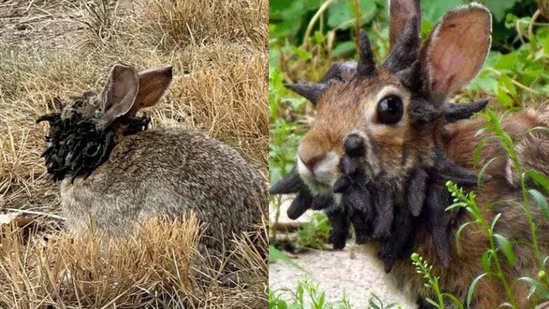What to know about Colorado’s mysterious “horned” rabbits — are they harmful to residents?

Wild rabbit in Colorado with Shope papilloma virus growths on its head
Residents of Fort Collins, Colorado, have been unsettled by the recent sight of wild rabbits bearing unusual black, spike-like protrusions around their faces. The eerie appearance of these animals has sparked both curiosity and concern in local neighborhoods.
One resident, Susan Mansfield, told KUSA-TV that she first encountered one of the odd-looking creatures two years ago. “It had what looked like black quills or toothpicks jutting from its mouth area,” she recalled. “I thought it wouldn’t survive the winter, but it came back the following year — and the growth had gotten bigger.”
Others have described the facial growths as “scabby” or “crusty,” leading some to dub the animals “Frankenstein rabbits.” A few have even speculated they might be jackalopes — a mythical hybrid of jackrabbit and antelope from American folklore, as noted by The Smithsonian.
However, wildlife experts have ruled out legend in favor of science. Kara Van Hoose, a spokesperson for Colorado Parks and Wildlife (CPW), told The Coloradoan that the strange facial growths are caused by a viral infection known as cottontail rabbit papillomavirus (CRPV). According to CPW’s official guidance, the virus triggers the formation of dark nodules around the rabbit’s head, which can elongate into horn-like shapes.
The virus is exclusive to rabbits and does not infect humans or other animal species. While it usually causes no lasting harm, the growths can be problematic if they interfere with a rabbit’s ability to eat or drink. CPW advises giving infected wild rabbits space to avoid spreading the virus to other rabbits, including domestic pets.
Van Hoose explained that the condition tends to appear in warmer months, when insects such as fleas and ticks transmit the virus between rabbits. “It’s something we commonly see in summer,” she said, adding that symptoms often subside during colder months.
Though the grotesque appearance of these rabbits may cause alarm, CPW notes that most wild cottontails recover naturally, with the growths eventually disappearing. In pet rabbits, however, CRPV infections can be more severe, and veterinary care is recommended.
For now, experts stress that while humans face no health risk from CRPV, it’s best to keep a respectful distance from any wild animal — horned or not.
What to Know About Colorado’s Mysterious “Horned” Rabbits
Reports of wild rabbits in Colorado sporting bizarre black, horn-like growths on their faces have captured local attention. These unusual sightings, primarily in Fort Collins and nearby neighborhoods, have prompted both curiosity and concern among residents. Many have described the animals as having dark, spike-like protrusions around their mouths and heads. The striking appearance has led some to nickname them “Frankenstein rabbits,” while others have speculated they could be mythical jackalopes, a hybrid of jackrabbit and antelope from American folklore.
The Cause
Wildlife experts, however, have clarified the phenomenon. The growths are the result of a viral infection called cottontail rabbit papillomavirus (CRPV). This virus causes dark nodules to form on the skin, which can elongate into horn-like structures, giving the rabbits their eerie appearance. The infection spreads primarily through bites from insects such as fleas and ticks, especially during the warmer months when insect activity peaks.
Impact on Rabbits
For wild cottontail rabbits, CRPV is typically not fatal. Most infected animals survive the virus, and the growths usually disappear on their own over time. In pet rabbits, however, the infection can be more severe, and veterinary care is recommended if they contract the virus. In some cases, the growths may interfere with a rabbit’s ability to eat or drink, making close observation necessary.
Risk to Humans and Other Animals
The virus is species-specific, meaning humans and other animals cannot be infected. Pet rabbits, though, could potentially contract CRPV if they come into contact with infected wild rabbits. Colorado Parks and Wildlife (CPW) advises keeping a safe distance from all wild rabbits, both to protect pets and to prevent further spread of the virus.
Seasonal Pattern
CRPV infections are most commonly observed during summer, when insect activity is highest and transmission is more likely. In wild rabbits, the infection usually subsides in colder months as the virus clears from the system, leaving the animals largely unharmed.
Expert Advice
Experts emphasize the importance of respecting wildlife. Infected rabbits should be given space, and pet owners should be vigilant if they suspect their rabbits are exposed. While the horn-like growths may appear frightening, they generally do not pose a serious health risk to humans or wild rabbit populations.
The so-called “horned” rabbits of Colorado are not a cryptid or urban legend, but the result of a natural viral infection. While their appearance is unsettling, most wild rabbits recover naturally, and humans face no direct danger. Keeping a respectful distance ensures both people and wildlife remain safe.

